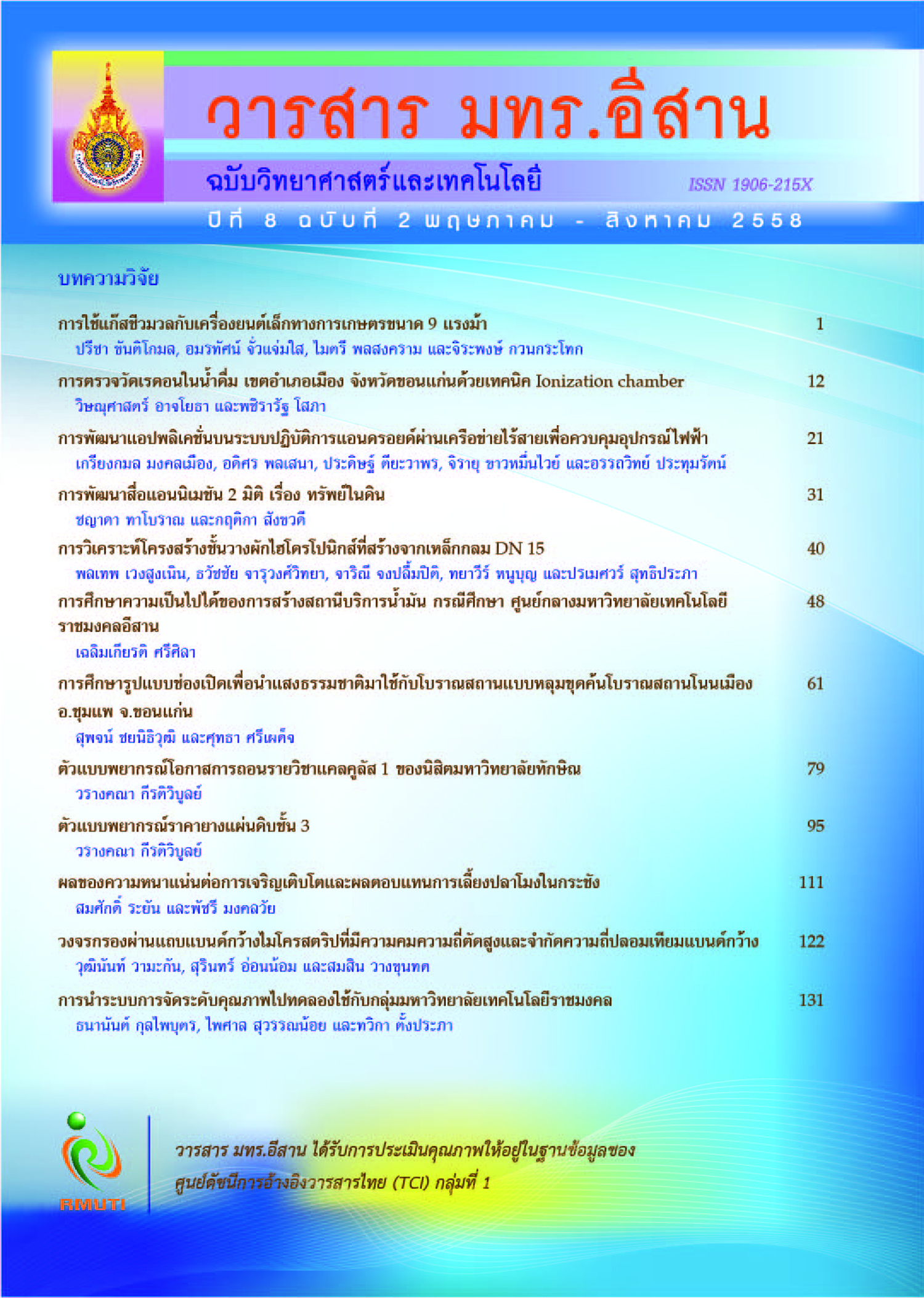การวิเคราะห์โครงสร้างชั้นวางผักไฮโดรโปนิกส์ที่สร้างจากเหล็กกลม DN15 DN15 Steel Pipe Structural Analysis of Hydroponic Tower
Main Article Content
Abstract
บทคัดย่อ
การวิเคราะห์โครงสร้างที่สร้างจากเหล็กกลม DN15 สำหรับการปลูกพืชไร้ดินแบบไฮโดรโปนิกส์เพื่อหาค่าความเค้นดึงและอัด ค่าการเสียรูปและค่าความปลอดภัยของการออกแบบ โดยการนำเอาระเบียบวิธีการทางไฟไนต์เอลิเมนต์มาใช้ในการวิเคราะห์และแสดงผล สามารถสรุปได้ว่าถ้าขนาดหน้ากว้างของโครงสร้างเท่ากับ 2 m แล้ว ค่าความเค้นสูงสุดที่เกิดขึ้นจะมีค่าระหว่าง 105.37 ถึง 138.01 MPa แต่ถ้าหน้ากว้างเท่ากับ 3 m แล้ว ความเค้นสูงสุดจะมีค่าระหว่าง 212.09 ถึง 262.90 MPa การเสียรูปที่ตํ่าที่สุดเท่ากับ 13.69 mm จะเกิดขึ้นเมื่อหน้ากว้างของแปลงปลูกเท่ากับ 2 m ส่วนการเสียรูป
ที่สูงที่สุดเท่ากับ 78.47 mm จะเกิดขึ้นเมื่อหน้ากว้างของแปลงปลูกเท่ากับ 3 m ในการวิเคราะห์ถึง
ความปลอดภัยจะพบว่าแบบหน้ากว้าง 2 m มีค่าความปลอดภัยอยู่ระหว่าง 1.81 ถึง 2.37 ซึ่งอยู่ในช่วงที่ปลอดภัย แต่ถ้าหากหน้ากว้าง 3 m จะมีค่าความปลอดภัยระหว่าง 0.95 ถึง 1.18 ซึ่งค่อนข้างที่จะเสี่ยงต่อการเสียหาย
Abstract
To analysis of DN15 round steel structure of the growing plants without soil, Hydroponic, investigated for tensile and compression stress, total deformation and safety factor using the Finite Element Method are analyzed and interpreted. The results show, the maximum stress of width structure of 2 m is 105.37 to 138.01 MPa. When width structure of 3 m is simulated, the maximum stress is 212.09 to 262.90 MPa. The lowest deformation is 13.69 mm occurs when the width structure is 2 m. The highest deformation is 78.47 mm occurs when the width structure is 3 m. To analysis of safety factor, the width of 2 m is 1.81 to 2.37 that is safety zone. In the case of width of 3 m, it has safety factor of 0.94 to 1.18 that rather risk of damage.
Article Details
References
ANSYS Meshing User’s Guide. Southpointe: ANSYS, Inc., 2011.
C. A. Felippa. (2001). Introduction to Finite Element Methods. Colorado: the Aerospace
Engineering Sciences Department of the University of Colorado at Boulder
C. S. Krishnamoorthy. (1994). Finite Element Analysis: Theory and Programming. 2nd ed.,
New Delhi: Tata McGraw-Hill Education.
D. S. Domingues, H. W. Takahashi, C. A. Camara and S. L. Nixdorf. (2012). Automated
system developed to control pH and concentration of nutrient solution
evaluated in hydroponic lettuce production. Computers and Electronics in
Agriculture. Vol. 84. pp. 53-61
G. Ramamurty. (2010). Applied Finite Element Analysis. New Delhi: I. K. International
Pvt Ltd, 2010.
G. Venter. (2010). Successful Hydroponics. Xlibris Corporation
H. M. Resh. (2002). Hydroponic Food Production: A Definitive Guidebook for the
Advanced Home Gardener and the Commercial Hydroponic Grower. 6th ed.,
New Jersey : Newconcept Press, Inc.
H. R. Roosta and M. Hamidpour. (2011). Effects of foliar application of some macro - and
micro - nutrients on tomato plants in aquaponic and hydroponic systems.
Scientia Horticulturae. Vol. 129. No. 3. pp. 396-402
Hydroponics. (7 July 2014.) Available: (http://en.wikipedia.org/wiki/Hydroponics)
Y. Kitaya, H. Hirai, X. Wei, A. Islam and M. Yamamoto. (2008). Growth of sweetpotato
cultured in the newly designed hydroponic system for space farming. Advances
in Space Research. Vol. 41. No. 5. pp. 730-735


